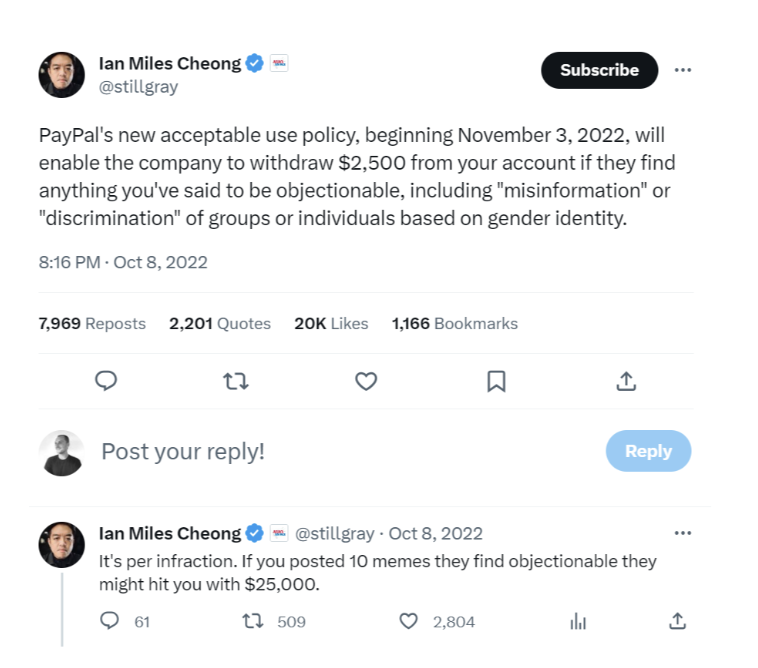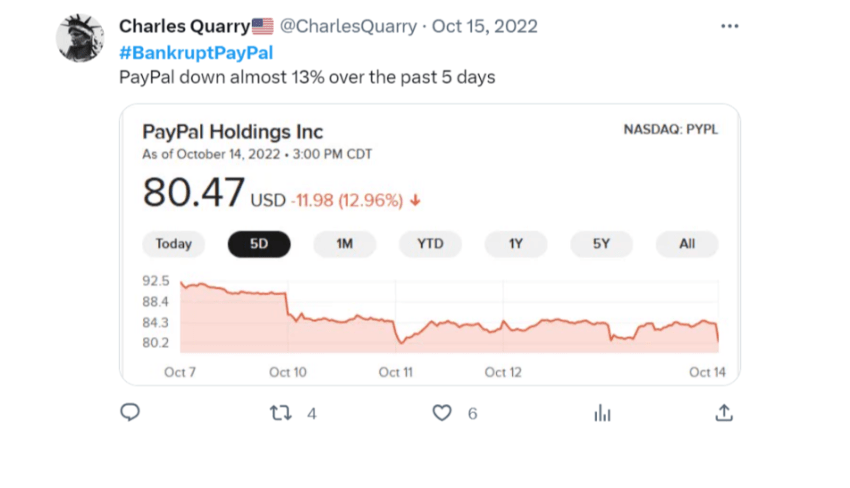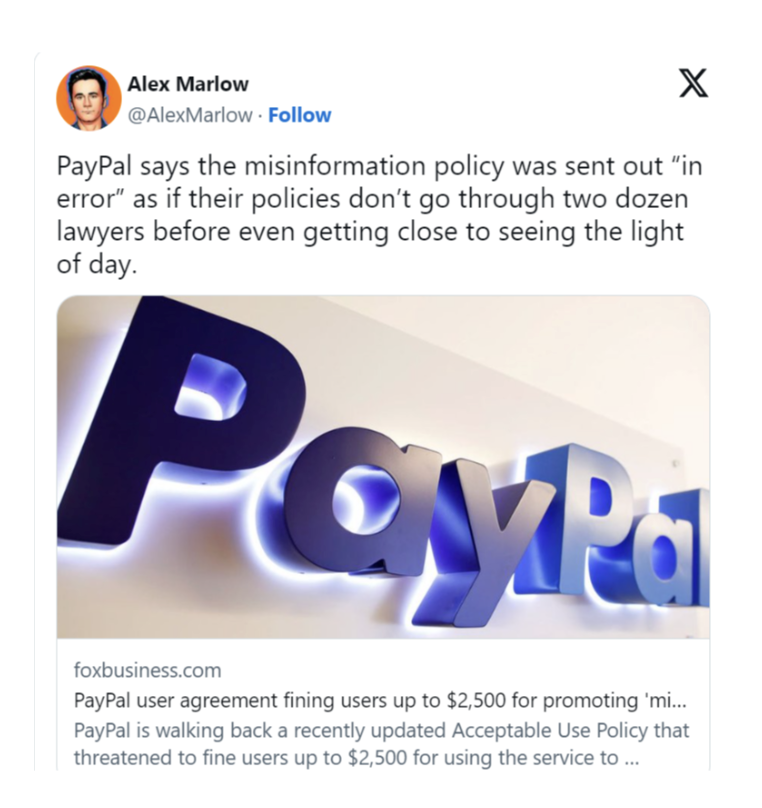Reputation and public perception are major contributors to sales, profits, and the success of any business.
Nothing damages a small business’s reputation more than a social media crisis. If left unchecked, a social media crisis can turn consumer sentiment against a brand. Negative comments received can serve as critical triggers for implementing response strategies, especially when they exceed certain thresholds, which can potentially impact the brand’s reputation.
It takes more than using social media management software to navigate a social media crisis. We’ll get into all that.
This comprehensive guide covers all aspects of social media crisis management relevant to small business owners.
With a preventative and proactive approach to social media crises, businesses can withstand mayhem and even bolster their brand’s reputation in the face of the nastiest social media disaster.
What Is a Social Media Crisis?
A social media crisis is a situation on social media where harmful content significantly harms the reputation or business operations of an individual, organization, or brand. This situation can arise from various unexpected events or controversies, such as the posting of offensive or insensitive content by the brand, customer complaints, or other misconduct by employees.
Social media crises often happen unexpectedly and threaten to damage a brand’s reputation.

It is important to note that negative feedback is common and should be monitored, but it does not always constitute a crisis.
In one survey, 69% of business owners reported experiencing a crisis over the past five years, and 95% of leaders indicated that their social media crisis action plans require improvement.
These crises can occur for many reasons, often beyond the business’s power to prevent—in many instances, all you can do is respond. But your decision-making in times of crisis and your response make or break the public’s perception of your business.
For example, a disgruntled customer’s negative post or review might go viral; an employee might upset a customer, or a social media post from your brand might be insensitive and misinterpreted by the public.

Social media crises can also arise if your business makes a decision that doesn’t align with customer expectations. For example, when PayPal decided to update its “Acceptable Use Policy,” it included a clause that allows PayPal to withdraw $2,500 from users’ accounts if that user posted anything the company deemed as “misinformation or offensive.”
Understandably, this resulted in a social media crisis with the Twitter hashtag (now X) #BankruptPayPal going viral, with customers spreading the news about PayPal’s decision and encouraging others to take action by closing their PayPal accounts:
The boycott directly impacted PayPal’s value, causing its stock price to drop by over 13% following the policy update. This shows the potential business impact of a social media crisis:

Other examples of social media crises include:
- False information is being spread about your company
- Security breaches exposing customers’ private data
- Illegal or inappropriate behavior by staff
If left unmanaged, these crises will spread rapidly through social media marketing platforms because nothing moves faster than bad news. This will ruin your public image, directly impacting sales, profits, and business success.ad news.
This will ruin your public image, directly impacting sales, profits, and business success.
The Importance of a Social Media Crisis Management Plan
Every small business needs a social media crisis management plan, regardless of size or industry. Social media crisis management is critical for every social media and communications professional.
It is essential to establish a crisis management team with defined roles and responsibilities. This team should comprise representatives from various departments to ensure comprehensive decision-making and preparation for potential challenges that may arise during a crisis.
This procedure outlines the roles and responsibilities during a crisis and provides established steps to follow. Such a plan helps you mitigate damage by responding quickly and effectively. A well-documented, flexible social media crisis plan will put you in the driver’s seat when it’s time to respond.
Critical elements of an effective social media crisis management plan include:
Defining a crisis response team
Who are the key internal stakeholders who will make decisions and deliver the response?
Typically, this includes social media policy managers, PR and communications spokespersons, customer service representatives, executives, and legal personnel, as needed. For instance, customer service representatives can provide insights into customer sentiments, while legal advisors can guide on compliance and regulatory considerations.
A well-structured crisis management team with clearly defined roles and responsibilities facilitates an efficient decision-making process. Involving representatives from various departments in this process is crucial for effective crisis handling and ensuring that everyone is prepared to respond swiftly and appropriately.
Monitoring and listening
How will you monitor social media and the web to detect emerging crises in real-time?
Utilize social listening tools to monitor brand mentions, hashtags, and negative comments. Tracking sentiment during a crisis is crucial as it helps brands identify potential issues and adapt their messaging in response to shifts in public perception.
Internal communication
How will information flow internally, and how will decisions be made quickly during a crisis?
Outline stakeholders, reporting structures, and channels. Utilizing platforms like Slack or Microsoft Teams can ensure swift communication among team members. This setup minimizes confusion and ensures that all members are on the same page, enabling a unified response to the crisis. Your crisis communication should also include internal communication to keep everyone on the same page.
External response strategy
How will you communicate externally across social media and other channels?
Have pre-approved templates and policies for social media posts and FAQ pages ready.
Addressing concerns promptly and effectively during a crisis is crucial. Social media serves as a vital tool for organizations to communicate with their audience, provide updates, and address stakeholders’ concerns.
Take the PayPal example, for instance. They monitored social media channels (and the stock market) and were ultimately forced to respond. PayPal went through news channels and stated that the notice “went out in error” (which isn’t the best way to face a social media crisis, but at least they responded):

Of course, each type of crisis or potential crisis must be assessed on its merits.
However, having a predetermined course of action, with go-to stakeholders and a communication system established, means you can respond rapidly and effectively, and practice damage control.
Post-crisis review
How will you evaluate the effectiveness of the response, make changes to policies and procedures, and report learnings to stakeholders?
Metrics and data should drive your review, particularly with real-world sentiment analysis and ongoing online discussions.
Testing and training
How will you train team members on procedures and test the plan with practice scenarios to identify gaps?
Training team members based on others’ mistakes is ideal in this case. The fewer social media crises your business experiences, the better.
One lesson we can pass on for sure is that failing to act during a social media crisis is one of the worst courses of action possible. You must react and manage the situation; how to do that best depends on its nature. The role of social media in crisis management goes far beyond publishing a heartfelt ‘we’re sorry’ Reel.
How to Manage a Social Media Crisis (7 Steps to Follow)
When a crisis emerges, having a plan allows your business to respond swiftly, decisively, and with the best chance of mitigating the fallout.
This step-by-step process can be a good starting point to help you develop your social media crisis response plan:
1. Assemble your crisis response team
Your crisis response team should comprise individuals from various departments within your organization, including, but not limited to, social media management, public relations, legal, human resources, and executive leadership. Each team member should have a clearly defined role, such as:
- Social Media Manager: Monitors online activity and manages the communication on social media platforms.
- Public Relations Specialist: Handles all media inquiries and crafts official statements.
- Legal Advisor: Provides legal perspective and advice on communication and actions.
- HR Representative: Advises on internal communication and employee-related issues.
- Executive Leader: Makes final decisions on the company’s response and actions.
Community managers play a crucial role in effectively managing unexpected crises. They must prepare for various potential challenges, such as product issues or public relations blunders, by implementing a solid crisis management plan to handle the real-time problems that may arise.
Clarify who needs to approve specific actions. Ensure every stakeholder is aware of the social media crisis plan.
2. Evaluate the situation
Before taking action, analyze the scale, facts, sentiment, key voices, media coverage, and overall impact of the emerging crisis. A surge in negative sentiment can indicate a potential crisis, necessitating a proactive strategy to address these feelings.
Categorize the nature of the social media firestorm and determine the appropriate level of response. Listen for misinformation to spread.
Analyze the Scale and Scope
- Measure the impact of the crisis on social media and other digital platforms. Examine metrics such as the number of mentions, shares, and the rate at which these numbers are increasing.
- Determine which social media platforms are most detrimental. For example, some crises may gain significant attention on Twitter but have little to no presence on Instagram. This knowledge will help focus your monitoring and response efforts.
Establish the Facts
- Collect all relevant information about the crisis. This includes the source of the issue, any developments, and the current state of public knowledge.
- Confirm the facts surrounding the crisis. Misinformation can exacerbate the situation, so it’s crucial to distinguish between what is true and what is not.
Assess Sentiment and Key Voices
- Use social media monitoring tools to gauge the public’s attitude. Is the overall sentiment angry, concerned, or supportive of your brand?
- Determine who is driving the conversation. This could be industry influencers, media outlets, or even aggrieved customers. Understanding who these key voices are can help you tailor your response effectively.
Examine Media Coverage
- Expand your monitoring to encompass not only social media but also news websites, blogs, and broadcast media. This can provide a better view of the crisis’s impact.
- Evaluate how the media is covering the crisis. Is the coverage factual, speculative, or sensational? The tone and spread of media coverage can influence public perception.
Categorize the Crisis and Determine Response Level
- Determine whether the issue is a product problem, a customer service failure, an employee-related incident, or something else. Different types of crises require different response strategies.
- Assess the potential impact of the crisis on your brand and stakeholders. This will help you determine the level of response required, ranging from a simple clarification to a comprehensive public relations campaign.
Listen for Misinformation
- Be vigilant for rumors or misinformation that may be circulating as part of the crisis. Quick identification of misinformation is crucial for timely corrections.
- Develop a strategy for correcting misinformation. This could involve direct responses on social media, updates to your website, or press releases.
Finalize the Evaluation
After thoroughly evaluating the situation, compile your findings into a comprehensive overview. This overview will serve as the foundation for developing a nuanced and effective response strategy.
Five W’s to Examine a Social Media Crisis
When a social media crisis erupts, employing the classic journalistic method of the Five W’s: Who, What, Where, When, and Why can be your guiding compass. This structured approach helps dissect the situation methodically, allowing for precise analysis and quicker response.
Who is Involved?
Understanding all the parties involved is crucial. Identify not only who instigated the crisis but also those who have become part of the narrative since it began. This could include influencers, customers, or even your own team members who may need to get involved to manage the crisis.
What is the Nature of the Incident?
Define the event as concisely as possible. Was it a negative review that went viral? Perhaps a hashtag that spiraled out of control? Focusing on the facts without emotion allows you to see the problem for what it truly is, much like a detective would.
Where Did It Occur?
Pinpointing the platform or location is key. Was the initial spark on Twitter due to a viral video or a Facebook post gone wrong? Knowing the ‘where’ helps you tailor your response to fit the nuances of each platform.
When did it Begin?
Timing can influence the intensity and spread of a social media crisis. Determine the exact time the issue started, as this can help manage the timeline for your response efforts and measure the impact over time.
Why Did it Happen?
Understanding the root cause of the crisis is essential. Did a frustrated customer trigger it? Or perhaps an accidental leak from within your team? Recognizing the why helps in crafting an appropriate response and potentially preventing future incidents.
Using these five angles not only clarifies the situation but also sharpens your response, mitigating the impact. This methodical assessment enables you to transform a crisis into an opportunity to demonstrate accountability and enhance your social media presence.
3. Get aligned on the next steps
Bring your team together to decide how to respond across all channels, including social media platforms and offline. Draft an official response for leadership approval.
Don’t wing it. Be direct about the action taken and the next steps. A well-crafted response plan for social media crises is crucial in mitigating damage to your brand’s reputation. Quick action, immediate acknowledgment of issues, and appropriate engagement with the audience are vital.
Here’s a strategy you can implement to formulate your response strategy:
- Decide on the response channels: Determine which channels will be used to respond to the crisis. This typically includes social media platforms where the crisis is most active, but can also extend to press releases, customer emails, internal communications, and offline channels if necessary. Start by identifying where your audience spends most of their time. Prioritize platforms that align with the message you need to convey. For instance, LinkedIn might be best for corporate communications, while Instagram could be more suitable for brand image issues.
- Outline the key messages: Develop the core messages that you need to communicate. These should address the nature of the crisis, what is being done to resolve it, and what customers and stakeholders can expect moving forward. Ensure that the messaging is consistent across all channels but tailored to the specific nuances of each platform. For example, the tone on Twitter might be more conversational, whereas a press release should maintain a formal tone.
- Draft an official response: Create an initial draft of the official response that includes the key messages. This draft will be refined and approved by leadership to ensure it aligns with the overall brand strategy and crisis management goals. It’s crucial to ensure that your response aligns with the expectations of each platform’s audience. Consider the types of content that perform well on each channel and adapt your message accordingly.
- Develop internal FAQs: As part of your strategy, ensure you anticipate the type of questions and feedback that might arise from your response. Prepare answers to potential questions and decide how to address further comments or concerns on social media and other channels. It’s essential to remain adaptable, as a social media crisis can evolve rapidly, requiring swift adjustments to your communication approach.
4. Respond promptly
Speed matters. Once your organization has determined the nature and path forward, post your official response on social media accounts and owned channels. Halt all further scheduled posts if you have them queued up. Continue monitoring and responding to comments in real-time. Inform decision-makers about the volume and sentiment of comments so they understand the growing (or declining) impact.
However, it’s essential not to rush blindly into action. Take a moment to pause and breathe.
Allow yourself to thoroughly assess the situation. Consider what your audience is feeling and expecting from your brand at this moment. Ask yourself if responding is necessary or if silence might serve better to de-escalate the situation.
When crafting your response, let empathy guide your words. Focus on addressing the audience’s needs rather than reacting defensively. Validating their feelings can turn a challenging moment into an opportunity for growth and learning. Remember, the goal is to maintain trust and demonstrate that you value their concerns.
As you move forward, balance the urgency of your response with the thoughtfulness your audience deserves. This approach ensures that you not only manage the immediate crisis effectively but also strengthen your brand’s relationship with its community for the long term.
After the initial flurry of activity, review the effectiveness of your response. Analyze what worked, what didn’t, and how your audience perceived the situation. Depending on the crisis’s impact, consider the next steps. This may involve a longer-term strategy to rebuild trust, address any systemic issues, or continue open communication with affected individuals and stakeholders.

5. Communicate effectively
Your communication should start with a genuine expression of concern for anyone affected by the situation. Empathy should be the primary goal of your message, conveying that you understand the impact of the crisis and genuinely care about the individuals involved.
It is crucial to acknowledge the people involved in a social media crisis, including customers and partners, and to consider the impact on those affected when communicating your response.
Choose words that convey understanding and compassion. Phrases like “We understand how this may affect you…” or “We are deeply concerned about…” can help in expressing empathy effectively.
For larger brands, crisis management involves equipping your customer support team with guidance on responding to inbound calls and tickets, as well as documenting or logging complaints. This way, agents aren’t in a position to fabricate answers or exacerbate the situation due to a recorded call.
Another thing to note is whether the social media crisis stems from an error or oversight by your organization. Take responsibility openly. Acknowledge the mistake, explain what is being done to rectify it, and outline measures to prevent future occurrences.
An outstanding example of ownership is Slack’s response to their downed systems last year:

Slack took the opportunity to endear itself to its users by thanking them for their patience and sharing part of its perspective on the issue.
6. Update all relevant channels
Start by ensuring that your official response and key messages are consistent across all platforms. This includes your website, blog, social media channels, email communications, advertising, phone messaging systems, and any offline materials or signage.
- For your website and blog: Your website often serves as the first point of contact for many people seeking information. Update your homepage with a clear and visible statement or link to more detailed information. Similarly, create a detailed blog post that explains the situation, the steps taken, and any future measures for prevention.
- For your emails: Tailor your email communications to acknowledge the situation, if appropriate. This can include dedicated emails to your customer base, updates in your regular newsletters, or targeted messages to affected parties.
- For your phone messaging systems: If your organization uses phone systems for customer support or inquiries, update the messaging to acknowledge the crisis and provide information or direct callers to where they can find more details.
- For all your ongoing advertisements: Evaluate your ongoing advertising campaigns across digital and traditional media. Pause or adjust ads that could be perceived as insensitive or irrelevant in the context of the crisis.
- For physical locations: If your company has physical locations, ensure that staff are informed and that any in-store signage or messaging is updated to reflect your response.
For example, Chipotle voluntarily shut down all its locations in response to an E. coli outbreak in its restaurants, allowing it to evaluate and train its team. All communications had a consistent, professional look and feel. As a result, Chipotle earned back consumer trust and improved its food prep procedures.
7. Continue monitoring sentiment
Keep listening to social media conversations and adjust your responses accordingly. Sentiment analysis can help you track whether the response is improving brand perception.
Gain valuable insights from analyzing customer sentiment and feedback during social media crises. Understanding these insights is crucial for enhancing products or services, thereby improving customer relationships and brand perceptions.
In Slack’s case, users reacted well to their social media crisis response, and the Slack social media team continued to engage with users on a personal, yet professional, level:

By doing so, Slack’s effective crisis management enabled them to strengthen their relationship with their customer base, rather than allowing a negative situation to damage their reputation. During a social media crisis, set up a digital “war room” for stakeholders to join and get answers quickly.
Conduct a post-crisis review to determine root causes and learn from successes and missteps. Implement updated policies to mitigate future risks.
Publicly updating policies is an essential step in managing a social media crisis.
Follow these proven PR techniques during the crisis response and post-crisis recovery:
Effective crisis management is crucial to counteract negative publicity that can arise from incidents like the United Airlines case, where a passenger was forcibly removed from a flight. The resulting outrage on social media not only tarnished the airline’s image but also emphasized the need for effective crisis management to rebuild trust with stakeholders.
Be quick, transparent, and truthful
Respond to crises immediately, and if possible, avoid delaying giving out the information you have. This is because people perceive this as neglecting to take responsibility, which can further worsen the situation.
It is crucial to respond quickly during a social media crisis by having a crisis management plan and clearly defined roles for team members.
Your aim here is to communicate as soon as possible, providing clear, concise, and accurate information. Transparency fosters trust; openly share what you know, what you don’t know, and what you’re doing to find out more.
Using this approach prevents misinformation and speculation from filling the void, helping to control the narrative.
Show empathy
Genuine empathy towards those affected is a key aspect of crisis communication. Your customers need to feel understood and valued, not just as a number but as individuals.
Issuing a sincere apology during a crisis is crucial. Brands like Slack and Burger King have effectively used sincere apologies to rebuild trust and demonstrate accountability, contrasting them with less effective responses that ignored public sentiment.
Ensure you acknowledge the impact of the crisis on them and what steps your brand is taking to mitigate their concerns. This humanizes your brand and builds emotional connections, which are particularly crucial during challenging times.
Apologize sincerely
People can smell a fake apology from a mile away — and companies that have been on the short end of the stick are still living with the scars. A notable example is Activision Blizzard’s scandal, which involved several instances of employee harassment and a subsequent public statement that exacerbated the situation.
A sincere apology can prevent a situation from escalating into a PR nightmare. By taking ownership of their mistake and issuing a sincere apology, companies can mitigate the negative impact and demonstrate their commitment to learning and improvement.
To avoid becoming another Activision Blizzard, give a heartfelt apology. It can go a long way in healing the wounds caused by a crisis.
Also, it’s important to accept responsibility without resorting to justifications or shifting the blame. A statement that acknowledges the mistake, expresses genuine remorse, and outlines clear steps for resolution is far more effective than defensive excuses. This demonstrates integrity and a commitment to making things right.
Stick to the facts
In the heat of a crisis, speculation and rumors can complicate the situation. Ensure that all communications are grounded in verified facts.
Addressing issues promptly is crucial to prevent them from escalating into a full-blown crisis, which can cause severe reputational damage. Monitoring social media and responding in a timely and well-considered manner are essential to mitigate potential crises.
Resist the urge to make assumptions or release unconfirmed information. If errors occur, correct them promptly and transparently. This helps you maintain credibility and manage the public’s expectations and understanding of the situation.
Bring in experts
It’s okay not to know how to handle this or have it figured out. In this case, citing or involving experts in your communications can enhance credibility and show that you are taking the issue seriously.
For instance, during social media crises, such as when a brand faces reputational damage due to negative incidents on social media platforms, expert involvement is crucial. Real-life social media crisis examples highlight how both large and small companies can benefit from expert guidance to navigate these challenges effectively.
Whether it’s industry specialists, crisis management professionals, or authoritative figures in your field, their insights can provide additional weight to your messages. This also demonstrates that you are not insular in your approach and are seeking the best solutions to the crisis.
Focus on solutions
After the initial crisis response, shift towards recovery and remediation. Detail what corrective actions are being taken and how you plan to prevent similar incidents in the future. This forward-looking approach reassures your customers that you are committed to improvement and resilience.
Having a broad checklist as part of your social media crisis management plan is helpful. This checklist serves as a comprehensive guide for stakeholders, detailing specific actions to take during various crisis scenarios, ensuring a swift and coordinated response from the crisis management team.
Update messaging
Your communication strategy should evolve with the crisis. Be prepared to adjust your messaging in response to new information, the current state of the crisis, and stakeholder feedback. This flexibility demonstrates responsiveness and an understanding of how crises can change rapidly.
It is also crucial to maintain a consistent message both internally within the company and externally to customers. Equipping internal teams with accurate information and guidelines prevents misinformation and ensures that all employees convey a consistent message, fostering cohesion.
Learn and improve
Every crisis presents an opportunity for growth. Reflect on what you learned during the event and how it can inform future practices. Evaluating the strengths and weaknesses of your crisis response is crucial to improving future strategies and enhancing communication across different teams within the organization. Share how these insights are being incorporated into policy changes, staff training, or other areas. This closes the loop on the current crisis and strengthens your brand’s resilience against future challenges.
Preparing for the Next Social Media Crisis
In addition to an emergency response plan, prepare for potential crises proactively:
- Establish guidelines for appropriate social media use by employees.
- Train customer service in direct messaging skills for rapid complaint resolution.
- Prepare templates for apology statements, status updates, holding statements, etc.
- Set up Google Alerts for your brand name, competitors, products, and other relevant terms to detect issues early.
- Conduct fire drills by simulating a crisis scenario and response. Learn from each practice run.
Utilizing social media as a crisis management tool is essential for prompt communication and providing timely updates during a crisis.

Key Takeaways on How to Handle Social Media Crises
With social media’s accelerated news cycle, crises can go viral instantly.
Protecting a company’s reputation during a social media crisis is crucial. Small businesses that prepare can minimize potential damage and maintain trust even under challenging situations. Remember these tips:
- Develop a documented social media crisis communication plan for your brand before issues arise.
- Monitor social media proactively for early warning signs of emerging crises.
- Assemble the response team quickly and objectively evaluate the facts, checking for misinformation.
- Respond rapidly with an empathetic, factual, and solution-focused narrative across social media channels led by your communications team.
- Continue to monitor, adjust messaging, and communicate transparently until the storm passes. Measure effectiveness using metrics.
- Learn from each crisis to improve policies, direct messaging skills, and overall readiness.
With the right mix of preparation and effective real-time execution, your small business can manage social media crises decisively.
Stay ahead of problems and let your customers see firsthand how much you care about them, not just in good times but also in bad. Two things will kill your chances of managing a crisis: an insincere response and no response at all.
Master social media customer care
Stop switching between tools as you market, engage and support your customers on social media. Do it all from one, integrated customer experience platform.
Social Media Crisis Management FAQs
A social media crisis is a situation where negative content or interactions on platforms like Facebook, X (formerly Twitter), or Instagram significantly threaten a brand’s reputation or operations. Social media crises can result from offensive posts, customer complaints, misinformation, or employee misconduct.
In fact, 69% of businesses have faced at least one social media crisis in the past five years, and 95% of leaders believe their response strategies need improvement.
Social media crisis prevention is rooted in proactive planning and monitoring. Start by implementing a clear social media policy, regularly training your staff, and using listening tools to catch issues early. Monitoring sentiment and online mentions helps you act before a crisis escalates.
One practical method is setting up Google Alerts and using social media listening software to track key terms and brand mentions.
The first step in social media crisis management is to assess the situation objectively. Determine the scale and potential impact of the issue, identify the platforms affected, and categorize the type of crisis that has occurred. Then, assemble your crisis team and begin real-time monitoring.
Early detection enables faster containment and tailored responses across all channels.
A crisis often involves significant customer outrage, potential legal issues, or widespread negative media coverage. Minor complaints typically involve individual customer grievances that can be resolved directly.
You should aim to respond within the first 24 hours of detecting a crisis. Fast responses demonstrate transparency and accountability. If you delay, public perception can spiral, leading to reputational harm. A well-prepared response plan with pre-approved statements helps businesses react swiftly while staying on message.
Yes, if handled with empathy, transparency, and accountability, a crisis can actually enhance trust in your brand.
Addressing the issue directly, admitting mistakes, and outlining changes can help build brand loyalty. For example, Slack’s transparent and empathetic communication during an outage helped increase user goodwill and engagement.
A comprehensive crisis management plan includes a clearly defined response team, social monitoring tools, internal communication workflows, pre-drafted public statements, and a post-crisis review process. Businesses should also simulate crisis scenarios to improve preparedness. Having a structured plan helps your team take coordinated action under pressure.
Continue to engage with your audience transparently, share positive updates and changes made as a result of the crisis, and consistently deliver excellent service. Avoid using humor, as it can be seen as insensitive. Rather, focus on empathy and resolving the issue.

















 Marketing & Sales
Marketing & Sales 











